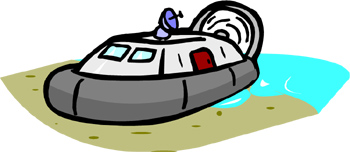How to Make a Hovercraft
Learning how to make a hovercraft sounds like a tough task. You might think building a hover vehicle sounds like something impossible, entirely out of science fiction. Those people may be wondering, “What the heck is a hovercraft?”
Hovercrafts are fun, inexpensive, low-flying disks or rafts that you can sit on and hover over a small area. Hovercrafts take many shapes and forms, but one thing they all have in common is the fact that they are air cushion vehicles (ACV) and ground-effect machines (GEM) – that is, they hover over the ground on a cushion of air.
One distinguishing feature of hover vehicles is they do not have wheels.
Making a Hovercraft
Building a basic hovercraft is easy and inexpensive, but hover devices break easily and look cumbersome. Many high school or even college students build simple hovercrafts as part of their physics curriculum or science fair projects.
However, building a quality hovercraft that can fly for a considerable amount of time can take much more money, patience and skill. Although the craft of building a Hovercraft is not difficult with the right tools, dimensions and power sources, you need to prepare for much trial and error.
How a Hovercraft Works
A hovercraft can move over any type of ground, water or other surface without too much trouble, because a hovercraft never touches the ground during standard operation. In a more complex hovercraft, an axial lift fan creates pressure and forces the hovercraft to trap a cushion of air in a chamber underneath the vehicle. A hovercraft skirt contains the air chamber, which operates between the belly of the vehicle and the ground it hovers over.
Air jets are installed on the sides of the hovercraft and blow air at a 45 degree angle in order to create pressure and lift. Modern hovercrafts include bag skirts and finger skirts that control the air pressure, stability and smoothness of the vehicle’s operation.
Plans for Your Hovercraft
If you are not sure how to make a hovercraft, consider buying or researching a hovercraft plan. For a basic home-made hovercraft, one professor at the University of Minnesota puts out a great step-by-step plan called the Human Hockey Puck.
Otherwise, if you are looking for a more professional design, Hovercraft dot com offers plans for hovercrafts that can seat one to more than ten people. In addition to hovercraft plans, the Hovercraft website also sells quality hovercraft parts and engines for the enthusiast.
How to Build a Hovercraft

How to Build a Hovercraft
Knowing how to build a hovercraft doesn’t have to be complex. Building a simple hovercraft involves two 48-inch diameter plywood discs, a vacuum cleaner, stool, nuts and washers, screws, a small wood block with a hole to attach the hose of a vacuum and a coffee can lid.
The top disc will serve as the top of your hovercraft on which a stool is attached so you can ride it. The hose of your home vacuum is attached near on a hole on top of your first plywood disk to supply the air pressure that will lift your hovercraft above the ground.
The bottom (2nd) plywood disc should be punctured with 12 1-inch air holes in 2 rows around the coffee can lidded center of the disc to enable the air from the vacuum to seep into an air chamber which will help lift you from the ground. The bottom of the 2nd disc should also be covered with thick plastic and stapled to the edges of the board so the air from the vacuum form the skirt pressure chamber that will make the hovercraft float.
Engines for Your Hovercraft
If you are looking to build a more complex, sturdier hovercraft, consider investing in a more powerful engine. Depending on what Hovercraft type and quality you are planning on achieving, you will need different engines.
For example, an engine for a basic hovercraft can consist of anything from a household vacuum to a simple leaf blower. However, a quality hovercraft that can fly outside without cumbersome vacuum cords on the ground requires anywhere between a 5 and 35 Horsepower engine.
Tecumseh builds a quality 5 Horsepower engine that is less than $200, which will serve a hovercraft which is built for simple recreational use. The Briggs 20 horsepower engine, which is priced at a little over $700, is considered a popular, reliable mid-range engine. Briggs also offers a 35 Horsepower engine for the wealthy enthusiast – it is priced at over $2200.
Whatever your preferred engine type and building plans, this Hovercraft Kit page and this article at Discover Hover are good resources, if you want to know the realities of building a hovercraft as well the practical and recreational uses for it.
Steering your Hovercraft
Installing movable rudders and a thrust propeller on the underside of your hovercraft will give a hovercraft more momentum and steering capabilities. Attaching a handlebar or joystick will give you full control of the rudders, in order to steer your hovercraft. Horizontal wings on your hovercraft play the role of a flight trim system, which enables the hovercraft driver to steer the hovercraft above ground.
Variations in the surface over which you drive your hovercraft will determine the speed of your vehicle at any given time. For example, tall grasses or high waves on the water will create a skirt drag and spray drag, which will slow down your vehicle.
When steering your vehicle, make sure you make turns well ahead of the actual turn. Use caution when turning a hovercraft because it uses a high turn radius.
Learning how to make a hovercraft can be a fun activity for families and students. Cheap, home-made hovercrafts take less time to build than complex hovercrafts but quality hovercrafts last longer and are safer to ride. The appeal to building a hovercraft is the fact that you are building an apparatus that will enable you to float over the ground.
